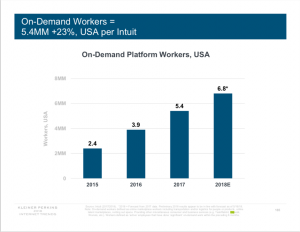In last week’s post I shared thoughts on the workforce of the future and how diversity could be the way to win the war for talent. It was one of three themes raised by Scott Duncan, MD of Aspire Executive Search and our guest speaker at a recent CMO dinner I hosted.
Today, we’ll tackle the second theme he highlighted: flexibility.
The Gig Economy and Flexibility
The gig economy offers a win-win situation in terms of flexibility. As an employer you only hire people when you need something done, so you aren’t locked into a contract that says you’re going to provide employment indefinitely. You also cut down on overheads. There’s no need to provide workspace, staff facilities and equipment. And you get to hire specific expertise.
From the freelancer or contractor’s perspective, they get the freedom that comes with working for themselves, often from home. And they can set their own working hours based on what needs to be done and by when. As a cherry on the top, they often earn more than full-time employees because there are no overhead costs for the employer. The secondary benefit is that you can specialise in the area you love or the area you excel and hopefully with this specialisation comes an increase in your fees.
There’s been a lot of hype about the gig economy with a great many experts weighing in on whether it’s the future of employment. But while some say that it’s the wave of the future, others beg to differ. A lot of organizations are talking about increasing their on-demand workforce, but few are planning for it, and even fewer are executing it.
However, change is happening, and some businesses are leading the way. One of the businesses with a representative at our dinner was already advertising flexible posts for work-from-home call centre agents.
Scott had a provocation that the gig economy was over-hyped and posed the question “How many people do you know in the gig economy?” I, for one, would be giving away trade secrets if I told you, but maybe the first draft of this blog was written by someone in the gig economy.
It might be early days for the gig economy however in the US there are 6.8m on-demand platform workers.
The Link Between Flexibility and Diversity
When we were discussing diversity, we noted the under-representation of women in high-level positions and at board level in particular. The lack of workplace flexibility in traditional models is partly to blame.
The NZ-based organization, Champions for Change, which works towards a more inclusive workplace, sees flexibility as one of the prerequisites that must be in place for the successful implementation of workplace gender diversity.
Employees are also family members, and the United Nations found that women spend 2.6 times more of their time doing unpaid caregiving work than men, often at the cost of their careers. This situation isn’t a win for men either. Most dads want to be part of their children’s lives as they grow, but career demands keep them away from their loved ones.
The NZ Herald reports that out of 59,000 births last year, only 324 men took paid parental leave. That’s less than one percent. And it’s not that they don’t want to be there. The Families Commission found that around half the men in a surveyed sample were unable to take parental leave and has called for fathers to get their own leave entitlement as a basic right.
The scales may be tipping towards Sweden’s model in which both parents are entitled to (and take) equal parental leave. And whether it’s because you want to explore the talent pool that opens when you implement gender diversity, or whether you’re preparing for a future in which men and women are equally entitled to paid time off for family responsibilities, flexibility will be the key.
Dynamics have to change at work – but also at home. Men must demand it, and Champions for Change models it. And of course, we have recently seen this change happening at the top with our very own PM and first man.
What Do You Demand Regarding Flexibility?
The fact of the matter is that as a business leader, you should be demanding flexibility too. Relying too heavily on key staff who you can’t spare for as much as a few weeks places your business at risk. Being flexible also allows you to explore real talent that would otherwise be overlooked. That’s another plus for you.
A video on the Champions for Change website offers an interesting case study. When implementing flexible employment terms as a means of promoting diversity, BNZ CEO Anthony Healy found that he wasn’t getting the results he was looking for.
Part of the problem seemed to be concern that certain jobs just can’t be flexible. But when Healy switched flexibility of posts from being a management “opt-in” to a mandatory requirement, things began to change. He concedes that flexibility isn’t always possible, and to address this, he allowed for a reporting procedure in which managers could still omit flexibility provided they compiled reports on why it wasn’t possible to incorporate it.
These reports weren’t just read and then filed away. Healy says that executives must consider “structural impediments” to flexibility and remove them wherever possible. With the new strategy in place, the amount of BNZ posts advertised with flexible options skyrocketed from 30 to 80 percent.
This lead to the inevitable question from Scott. “As a business leader how could you match this performance?”
What Do You Create to Enable Flexibility?
We have the technology that can enable flexibility, but what we might lack is the organizational culture that will promote it. As usual, the tech companies are taking the lead, and there are some big names implanting out-the-box methods in order to deliver on workplace flexibility. They include:
- A “take what you need” approach to leave and time off
- A results-only work environment
- Remote work options
- A flexible approach to timekeeping
- Job sharing
Which of these approaches will work for you? Don’t discard them out of hand. Think them through. Even the US government is getting on the bandwagon.
Key Takeaways
- The gig economy is on the rise in the US. Elsewhere, progress is slow, but there’s a good case for investigating its opportunities.
- Flexibility will allow your business to build greater diversity – and give both men and women an opportunity to balance work and family life.
- Flexibility requires more than lip-service to the concept. It should be a priority at executive level so that obstacles to flexibility can be removed through organisational change.
- There are lots of ways to bring flexibility to your staffing model and HR strategy, but it will require out-the-box thinking and a “can-do” attitude.
KS





